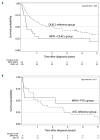Myeloproliferative and lymphoproliferative malignancies occurring in the same patient: a nationwide discovery cohort
- PMID: 33054083
- PMCID: PMC7556673
- DOI: 10.3324/haematol.2019.225839
Myeloproliferative and lymphoproliferative malignancies occurring in the same patient: a nationwide discovery cohort
Abstract
Myeloid and lymphoid malignancies are postulated to have distinct pathogenetic mechanisms. The recent observation that patients with a myeloproliferative neoplasm have an increased risk of developing lymphoproliferative malignancy has challenged this assumption. We collected a nationwide cohort of patients with both malignancies. Patients diagnosed in 1990-2015 were identified through the national Danish Pathology Registry. We identified 599 patients with myeloproliferative neoplasm and a concomitant or subsequent diagnosis of lymphoma. Histopathological review of the diagnostic samples from each patient led to a final cohort of 97 individuals with confirmed dual diagnoses of myeloproliferative neoplasm and lymphoma. The age range at diagnosis was 19-94 years (median: 71 years). To avoid the inclusion of cases of therapy-induced myeloproliferative neoplasm occurring in patients previously treated for lymphoma, only patients with myeloproliferative neoplasm diagnosed unequivocally before the development of lymphoma were included. The average time interval between the diagnoses of the two malignancies was 1.5 years. In the majority of patients (90%) both diagnoses were established within 5 years from each other. Among the lymphoma entities, the frequency of peripheral T-cell lymphomas was markedly increased. Interestingly, all but one of the T-cell lymphomas were of angioimmunoblastic type. These findings suggest that myeloproliferative neoplasm and lymphoproliferative malignancy developing in the same patient may have common pathogenetic events, possibly already at progenitor level. We believe that the molecular characterization of the newly developed biorepository will help to highlight the mechanisms driving the genesis and clonal evolution of these hematopoietic malignancies.
Figures



References
-
- Lemonnier F, Couronne L, Parrens M, et al. Recurrent TET2 mutations in peripheral Tcell lymphomas correlate with TFH-like features and adverse clinical parameters. Blood. 2012;120(7):1466-1469. - PubMed
-
- Couronne L, Bastard C, Bernard OA. TET2 and DNMT3A mutations in human T-cell lymphoma. N Engl J Med. 2012;366(1):95-96. - PubMed
-
- Sakata-Yanagimoto M, Enami T, Yoshida K, et al. Somatic RHOA mutation in angioimmunoblastic T cell lymphoma. Nat Genet. 2014;46(2):171-175. - PubMed
Publication types
MeSH terms
LinkOut - more resources
Full Text Sources
Medical

